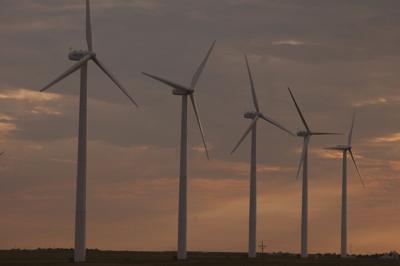I wouldn’t call it a pot of gold at the end of the renewable rainbow, but call it a growing cash crop on the Eastern Plains, and it flourishes in abundance.
Sun and wind on the wide-open spaces of Colorado could fill a gaping hole in the region's economy with new opportunities. Late last month my friends over at The Western Way released a report detailing $9.4 billion in investments in renewable energy on the plains already. The analysis provides kindling for a hot conversation on what more could be done to help this region and its people to prosper from the next big thing.
Political winds of change are powering greener energy to the point that conservative organization and rural farm interests are certainly paying attention if not getting onboard.
Gov. Jared Polis and the Democrats who control the state House and Senate have the state on course for getting 100% of its energy from renewable resources in just two decades. Those who plan for that will be in the best position to capitalize on the coming opportunities.
The Eastern Plains, economically wobbly on its feet for years now, doesn’t plan to be left behind any longer. Folks out there, battered by a fading population, years of drought and fewer reasons to hope for better days, are ready to try something new, something with dollars attached to it.
Renewable energy is not the whole answer for what troubles this region, but it’s one answer, said Greg Brophy, the family farmer from Wray, a former state senator and The Western Way’s Colorado director. The Western Way is a conservative group concerned about the best possible outcomes for business and conservation in a changing political and economic landscape.
In the General Assembly, Brophy wrote a law that based property taxes on the value of the electricity generated. One good wind turbine could net a landowner $10,000 a year in lease payments, and that ain't chicken feed, Brophy said.
It also makes a bigger political statement that bears listening to.
“It’s a market-based solution to concerns people have with the environment,” Brophy said. "Whether you share those concerns or not, a lot of people are concerned, and rather than doing some silly Green New Deal, we actually can have a market-based solution that can provide lower cost electricity.”
Brophy was an early Trump supporter, a GOP candidate for governor and the former chief of staff to U.S. Rep. Ken Buck. He’s dismayed at the president for mocking wind energy.
He thinks some healing of our broken nation could take place if people looked more for win-wins.
Take the mountain plover. When the migratory shore bird was threatened because of accidental losses of nests in fields, farmers stepped up and changed practices without the need for the heavy hand of government.
Both sides have to be willing to set aside conflict and fundraising for the common good, which is increasingly uncommon.
Renewable energy checks all the boxes: It helps farmers, it helps the planet and it gives Republicans and Democrats in Denver and D.C. one less thing to argue about.
“For people on the left, they’re getting something they want out of it, and for guys like me who are conservative to say, ‘See, here’s a market-based solution to your problem.' It's good for the left and it puts some money in the pockets of the people I care about in Eastern Colorado.”
Family farms already squeeze a lot of diversity out of their operations, which is critical at a time when tariffs and trade deals cut deeply into crop and livestock profits.
“I don’t think it’s ever going to be as lucrative as oil and gas," Brophy said of wind and solar development, "but it’s big enough to make a heck of an impact.”
Polis, the state's highest ranking green energy advocate, sounded like it was all part of the promise he made when he entered the governor’s race three years ago.
“My commitment to achieving 100% renewable energy by 2040 is motivated not only by our obligation to protect our air, our water, our climate and our way of life," he told Insights. "It’s also a tremendous opportunity to create more good green jobs and while ensuring our economy is resilient and diverse especially on the Eastern Plains.”
San Luis Valley rancher Don Shawcroft, president of the Colorado Farm Bureau, said something’s got to give.
"Farmers and ranchers look for any way they can to diversify and find new income sources when times are tough,” he said. “Particularly now when the agriculture industry is in its eighth year of declining farm income, renewable energy leases can be an important tool in their toolbox. Yet, with promises for rural areas comes complications such as disruption of vast open view sheds, location of transmission sites and the tendency for a boom and bust to local economies.”
He said the Colorado Farm Bureau, the biggest backer of farmers and ranchers, has long advocated for the cost-effective supply of energy. For a long time, that’s been oil and gas, but now things are changing.
“As society clamors for renewable transition, it's important that it's not on the backs of rural Colorado," he said, to which all Coloradans should wholeheartedly agree.







(0) comments
Welcome to the discussion.
Log In
Keep it Clean. Please avoid obscene, vulgar, lewd, racist or sexually-oriented language.
PLEASE TURN OFF YOUR CAPS LOCK.
Don't Threaten. Threats of harming another person will not be tolerated.
Be Truthful. Don't knowingly lie about anyone or anything.
Be Nice. No racism, sexism or any sort of -ism that is degrading to another person.
Be Proactive. Use the 'Report' link on each comment to let us know of abusive posts.
Share with Us. We'd love to hear eyewitness accounts, the history behind an article.